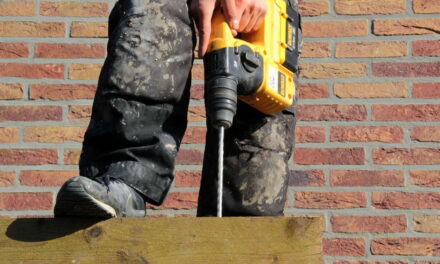‘How To Lay Carpet Tiles’ takes an in depth look at how you can lay your own carpet tiles. Carpet tiles are the best solution for DIYers who want a carpeted room without the expense of hiring someone to do it. Laying a full carpet can be extremely tricky, especially if you’re doing it for the first time. Carpet tiles give you the freedom to make mistakes that don’t turn into crisis situations. If you make a measuring or cutting mistake with one carpet tile, you can correct it without a feeling of devastation.
Although carpet tiles can change the entire look of a room, it has to be said that they don’t look as luxurious as full carpets – especially in living rooms. On the other hand, carpet tiles have several advantages:
- They can be partly replaced if they’re stained
- They can be taken up and re-laid in a different location when wear and tear set in
- When damaged, they can easily be replaced without the expense of having to rip out and start again.
Difficulty rating for fitting carpet tiles yourself: 5 out of 10
Time: depends on the size of the room, but an average sized dining room can be finished in 2-3 hours if all preparations are made before-hand.
Materials and tools you’ll need to lay carpet tiles:
Carpet tiles (get a couple of extra boxes to cover mistakes and for future needs. Remember that stockists change materials every few years). Don’t forget to measure alcoves or bay areas in the room.
Double-sided carpet tape or carpet glue spray. (I prefer the spray because it gives better coverage).
You may need a threshold bar if you don’t already have one.
A good quality utility (commonly called ‘Stanley’) knife, and extra, heavy-duty blades.
A ruler
Chalk or pencil
A tape measure
Preparations before laying your carpet tiles
Assuming you’ve already stripped the floor of its previous covering, make sure that all dust, debris, paste, nails and/or grease have been removed from the surface.
You need a dry, flat and clean surface before laying your carpet tiles. Please note that carpet tiles can’t be laid on previously carpeted floors. It’s okay to lay tiles on wooden, tiled or concrete floors as long as they’re even and flat. Uneven surfaces can be treated with resin, which can be obtained from your local DIY shop. Your stockist will be able to guide you towards the right resin – depending on your floor. If you have wooden floors with space between the floorboards you’ll need to cover these with sheets of plywood before continuing.
Be aware that tiles have to be laid in the order of their directional arrows on the reverse.
How to lay carpet tiles
1. Without gluing down the tiles, start (a dry run) from the centre of the room and lay a row of tiles from there to one end of the room. You don’t want to start from the end because this will leave gaps near the skirting board. You may also be left with one end of the room where all the tiles have tiny, end pieces. This looks unprofessional.
2. When you get to the wall you’re working towards you should have about half the space of a carpet tile left. If the space is less than this, go back to your first tile (the one in the middle of the floor) and move your starting line back about half a tile. Repeat the above step.
When you’ve got a reasonable sized gap at the end of the room – one you’re satisfied with – go back to your starting tile and complete the row by laying carpet tiles to the opposite end of the room. If you’re happy with both gaps continue to the next step. If not, adjust your starting line and repeat the steps.
3. Once this first line/row of carpet tiles has been dry-laid satisfactorily, lay another row of tiles to the opposite ends of the room ( in the shape of the letter ‘t’). Check this to make sure you’re happy, then bring out your carpet glue spray or double-sided carpet tape.
4. You will tape (or glue down) every four tile, but don’t glue down the last tile in each row. You have to remove this when it comes to finishing off the room. Make sure there is no space between the tiles and no carpet pile between the gaps. Work carefully and meticulously. It’s quicker this way, rather than to have to take up the tiles when the entire room is finished.
Once all the whole tiles have been laid, it’s time to work with the corners.
Laying carpet tiles in the corner of the room
You’ve now laid all the whole carpet tiles you can lay. Now it’s time to finish off the corners of the room by cutting tiles to fit these spaces. It’s very easy to do.
1. Start at one end of the room. First, remove the last whole tile in the first row and replace it with the carpet tile you’re going to cut.
2. Put the whole carpet tile you’ve just removed on top of the one you’re going to cut. After making sure that it’s flush against the skirting board, use your pencil or chalk to draw a line on the bottom carpet tile (the one you’re going to cut). The mark should be drawn on the line where the top carpet tile stops.
3. Remove the (marked) carpet tile to be cut, and put the original tile back in its place. Use your blade (and ruler for a straight edge) to cut the tile.
4. When the carpet tile is cut, check that it fits, then secure it to the floor with carpet tape or carpet glue spray.
5. To work around obstacles like radiator pipes etc, make a cardboard template of your carpet tile. Cut around this template and make your mistakes on this. Once you have it perfectly cut, place the template on your carpet tile, draw around it and cut to suit.
When cutting holes for pipes, cut a slit at the end of your tile, then cut the holes as per measured. This slit will enable you to slip the tile around the pipes.
Your finished room
Once your room is finished, you should be able to use it straight away because both forms of glue dry instantly.
Treat your carpet tiles the way you would treat any other carpet. Treat stains straight away, vacuum regularly and shampoo when necessary. Keep your extra carpet tiles in a clean, dry place so they’re in good condition when you’re ready to use them.
If you liked ‘How To Lay Carpet Tiles’, please share it on your social networking sites. You can find more DIY tutorials on the linked page.






I always hesitant with the carpet tiles because I don’t know how to put those things on. I don’t have money, other to do it for me.
Hi Anne,
This is very useful tips and easy to follow. I am planning to hire contractors for the renovation of the entire area of my room to make it looks elegant. Thanks for sharing your informative article. I’d love to visit your page more often.
Hi Anne,
These are some great DYI tips. Strong knees and a good back aren’t bad to have either. 😉 I’m going to have to come back to your site for more How to’s.
Thanks,
Robb